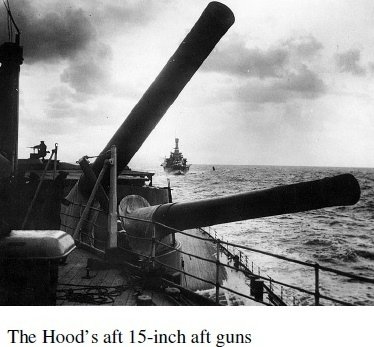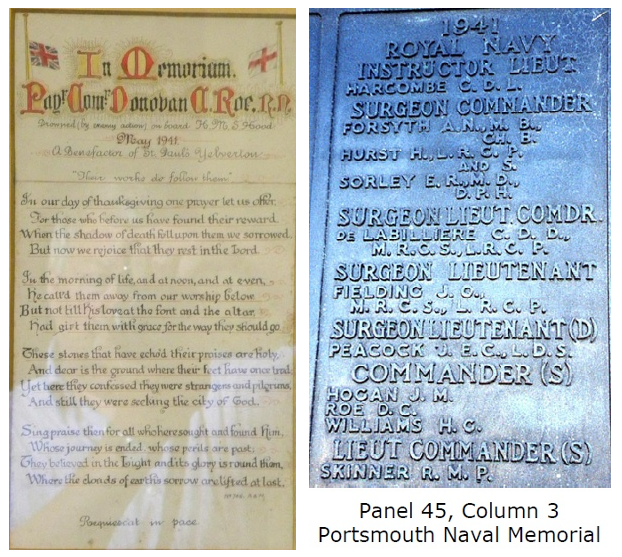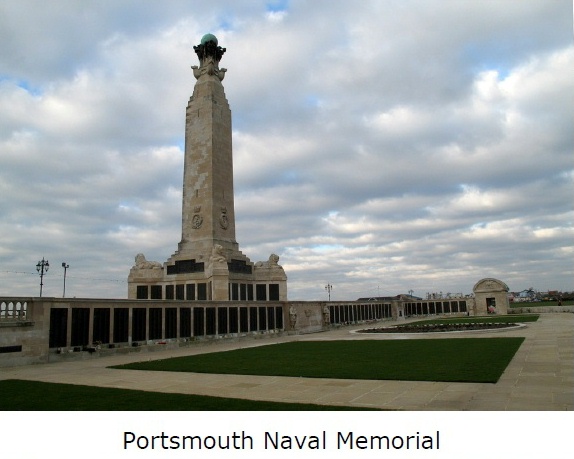D.C. ROE
 Donovan Connor Roe was the only son of Richard George Tennant Roe (1870- 1928) and Bertha Nugent (nee Nixon) (1870-1946). He was born on 4 October 1892 in Bideford and christened on 11 June 1898 at Great Bedwyn Church, Wiltshire when he was 5. His parents moved to Yelverton when his father beame an engineer’s draughtsman in the Plymouth Dockyards.
Donovan Connor Roe was the only son of Richard George Tennant Roe (1870- 1928) and Bertha Nugent (nee Nixon) (1870-1946). He was born on 4 October 1892 in Bideford and christened on 11 June 1898 at Great Bedwyn Church, Wiltshire when he was 5. His parents moved to Yelverton when his father beame an engineer’s draughtsman in the Plymouth Dockyards.
After leaving school Donovan enlisted into the Royal Navy in July 1910. After taking all the various accountancy examinations at HMS Mars, he was made an assistant clerk and then on 15 October 1913 Assistant Paymaster. From 1914 to 1918 he served as clerk to the secretary of staff in the Africa Station. Whilst there he was promoted to Paymaster Lieutenant. He was awarded the three usual World War I medals, The Star, Victory and British War affectionately known as Pip, Squeak & Wilfred!
 After the war he was on the staff of Rear-Admiral M R Hill at Simonstown. In 1920 he served aboard HMS Gibraltar and then on the battleship HMS Resolution until 1923 when he was promoted to Paymaster Lieutenant-Commander.
After the war he was on the staff of Rear-Admiral M R Hill at Simonstown. In 1920 he served aboard HMS Gibraltar and then on the battleship HMS Resolution until 1923 when he was promoted to Paymaster Lieutenant-Commander.
He returned to England in 1924 to serve at the Royal Navy Barracks at HMS Vivid, Devonport. In 1926 he was the Accounting Officer on the surveying ship HMS Herald. In November 1928 he returned to England on board the Narkunda from Hong Kong. He was nnow 36 and gave his address as 2 Leighan Terrace, The Hoe, Plymouth. He returned to HMS Vivid as the Assistant Drafting Officer until January 1932. Whilst at HMS Vivid he was promoted to Paymaster Commander. After a brief spell at HMS President (The Admiralty) , he served as Accounting Officer on the cruiser HMS Berwick (China Station) and then to the Mediterranean board the depot ship HMS Cyclops from 1935 to 1937. Whilst there he was also Accounting Officer to the 1st Submarine Flotilla.

 In October 1937 he returned to Devonport to serve in the torpedo school HMS Defiance. With war looming he was transferred to HMS Hood becoming the Battle Cruiser Squadron Accounting Officer.
In October 1937 he returned to Devonport to serve in the torpedo school HMS Defiance. With war looming he was transferred to HMS Hood becoming the Battle Cruiser Squadron Accounting Officer.
HMS Hood was the last battlecruiser built for the Royal Navy. Named after the 18th-century Admiral , she was commissioned in 1920. After circumnavigating the world a couple of times she was assigned to the Mediterranean Fleet. She returned home in 1939 for an HMS Hood overhaul. Advances in naval gunnery had reduced the Hood’s usefulness so she was scheduled to undergo a major rebuild in 1941 to correct these problems. The outbreak of war, however, forced the boat back to sea without any upgrades. Early days of the war showed her operating around Iceland and the Norwegian Sea. She then participated in the destruction of the French Fleet at Mars-el-Kebir. Next it was up to Scarpa Flow as a convoy escort.
 On 24 May 1941 HMS Hood and the battleship Prince of Wales were ordered to intercept the German battleship Bismark and the heavy cruiser Prinz Eugen. The German boats were on their way to the Atlantic to attack convoys. On 24 May the British opened fire at 05:52 with Hood engaging Prinz Eugen. The Germans returned fire at 05:55, both ships concentrating on Hood. Prinz Eugen was probably the first ship to score when a shell hit Hood's boat deck, between her funnels, and started a large fire among the ready-use ammunition for the anti-aircraft guns and rockets. Just before 06:00, while Hood was turning 20° to port to unmask her rear turrets, she was hit again on the boat deck by one or more shells from Bismarck's fifth salvo, fired from a range of approximately 16,650 metres. A shell from this salvo appears to have hit the spotting top as the boat deck was showered with body parts and debris. A huge jet of flame burst out of Hood from the vicinity of the mainmast, followed by a devastating magazine explosion that destroyed the aft part of the ship. This explosion broke the back of Hood and the last sight of the ship, which sank in only three minutes, was her bow, nearly vertical in the water. Of the 1,418 crew, only threemen survived.
On 24 May 1941 HMS Hood and the battleship Prince of Wales were ordered to intercept the German battleship Bismark and the heavy cruiser Prinz Eugen. The German boats were on their way to the Atlantic to attack convoys. On 24 May the British opened fire at 05:52 with Hood engaging Prinz Eugen. The Germans returned fire at 05:55, both ships concentrating on Hood. Prinz Eugen was probably the first ship to score when a shell hit Hood's boat deck, between her funnels, and started a large fire among the ready-use ammunition for the anti-aircraft guns and rockets. Just before 06:00, while Hood was turning 20° to port to unmask her rear turrets, she was hit again on the boat deck by one or more shells from Bismarck's fifth salvo, fired from a range of approximately 16,650 metres. A shell from this salvo appears to have hit the spotting top as the boat deck was showered with body parts and debris. A huge jet of flame burst out of Hood from the vicinity of the mainmast, followed by a devastating magazine explosion that destroyed the aft part of the ship. This explosion broke the back of Hood and the last sight of the ship, which sank in only three minutes, was her bow, nearly vertical in the water. Of the 1,418 crew, only threemen survived.
The wreck of Hood was discovered in 3,000 metres of water in July 2001. In 2002, the site officially became a war grave.
Probate gives his address as Addington, Yelverton which was his parents home. His father had died in 1928 but his mother, now aged 71, still lived there. He left her his entire estate of £2,246 8s 10d. She died in 1946.
Commander Donovan C Roe is commemorated on the Portsmouth Naval Memorial on Panel 45, Column 3. Also on the Buckland Monachorum War Memorial at Crapstone and on the framed parchment in Yelverton Church. The church also contains a framed certificate “In Memor ium Paymaster Commander Donovan C Roe, R.N. ” The text is hymn 746 in Ancient & Modern“ In Remembrance of Past Worshippers”

